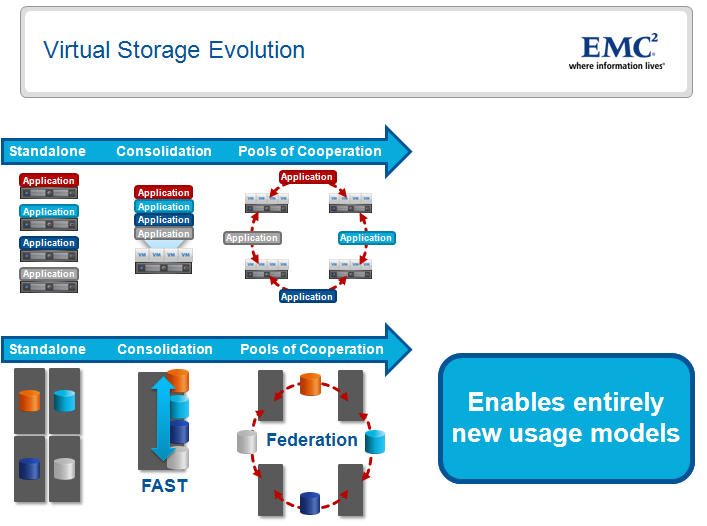EMC launches VPlex, eyes teleporting petabytes globally

EMC is looking to do for storage what VMware did for servers: Make assets easier to pool and move around.
At EMC World Monday, the company outlined its plans and products for virtual storage infrastructure. In a nutshell, the movement is on to be able to pool storage, share it over distance and cut through the physical limitations of data (having it stored in one location over another).
To that end EMC is rolling out a portfolio of products dubbed VPlex, which an effort to pool storage across multiple data centers and swap information across long distances. This model would fall under the private cloud model where data is pooled and shared across a company. For instance, a backup data center in Oregon could take over batch processing for its sister site in Secaucus, N.J.
Brian Gallagher, president of EMC's Symmetrix and virtualization product group, said the storage giant's VPlex platform can create an abstraction layer for physical disk space and information. With that layer---similar to the virtualization layer deployed by VMware---companies can leverage existing storage assets as well as manage the information lifecycle.
The company's pitch is part product and part architecture. The bottom line is that EMC sees a world where petabytes of information can "commute" and "teleport" across data centers all over the globe.
EMC and other storage vendors have pitched information lifecycle management---a concept where data is managed through different value and security levels until it is destroyed---but "customers had to classify data and didn't have the staff to do it," acknowledged Gallagher. By creating a layer to manage and set policies across all data, that information lifecycle management vision should be easier to digest.
EMC Vplex will turn physical storage systems into virtual machines where enterprises can move information easily anywhere. Among the use cases:
- A company can schedule batch processes in areas with lower energy costs;
- Move operations out of a region in case of a disaster;
- And better balance workloads by utilizing what was a passive backup data center.
VPlex, along with EMC's FAST (fully automated storage tiering) are two building blocks to create a federated storage picture. By federating storage, local systems are pooled into one virtual data center. You can expect EMC to talk a lot about the private cloud and data at a distance going forward. NetApp has begun talking about data at a distance as a pre-emptive strike against EMC's announcement.
Bottom line: The concept that disparate data centers can act as one across different locations is taking shape.
The VPlex lineup includes two flavors---Local and Metro---available today and an installment to land in 2011. Here's the breakdown of EMC's product lineup, which has naming conventions similar to telecom gear:
- VPlex Local: Moves data across a data center between EMC and non-EMC gear. It features one cluster with up to 4 VPlex engines and 8,000 virtualized storage volumes.
- VPlex Metro: These systems link two VPlex clusters in a data center or up to 100 kilometers apart. Metro can federated all or some storage volumes across both clusters and synchronize and relocate I/O data between two sites. Supports VMware, Microsoft Windows Server 2008 R2 Hyper-V and virtual machines from Oracle and Red Hat Linux.
- VPlex Geo: Geo will enable asynchronous federation of clusters and support data migration and relocation over cross-continental differences. These systems will land in early 2011.
- VPlex Global: This storage system will enable distributed data access across synchronous and asynchronous distances globally.
These systems start at $77,000.
